April 24, 2013 · 8:01 am
This weekend the national Spec Fic convention, Conflux, is being held in Canberra. It’s a fun-filled long weekend for fans of the genre, where you get to talk about the genre you love with other people who share your passion. There will be a packed program with workshops, panels and events, (see Thursday, Friday, Saturday and Sunday here). Here is but a brief glimpse of the things on offer.

Thursday, Richard Harland will be there with bells on running a Writing Steam punk workshop from midday until three. Richard’s had a wonderful time in France recently, promoting his Worldshaker series. As you can see, he gets right into the steam punk era.
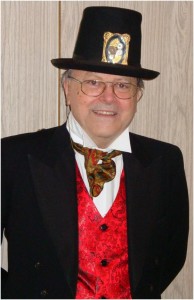
At 4pm there will be a Steam Punk High Tea. What could be more delicious? And then there’s the Opening Cocktail party at 7:45pm.
Friday, 11 am Fablecroft Press will be launching One Small Step (Go Tehani). (One of my stories is in this anthology). Unfortunately, I have to work on Friday so I won’t be able to make the launch. I’ll fly down late Friday night and stagger into my hotel room.
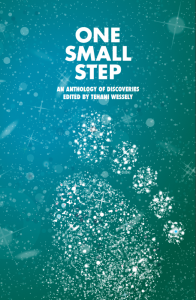
At 2:30pm there’s a Guest of Honour interview with Marc Casgione, Publishing Director of Angry Robots. (more on the GoHs down below.
And you can’t miss the Regency Gothic Banquet starting 7pm.

Gorgeous gloves from this site.
On Saturday morning I’ll be running a workshop preparing lucky authors who will pitch their books to Marc Gasciogne later the same day.
At 2:30pm there will be a Guest of Honour interview with Naolo Hopkins, writer of challenging SF.
And at 5pm the Ditmar Award Winners will be announced, along with the winner of the Hemming Award.
8pm, the attendees will let their hair down at the Junkyard Cathedral Masquerade.
Sunday there will be a panel on Book Covers, which I’ve been prepping for. And I’m sure there will be a fierce debate of the possibility of a female Dr Who at 12:30pm. (I saw plenty of female Dr Whos at Supanova).

Is the World ready for a Female Dr Who? by Vinne Bartilucci
See here for a full list of workshops, events and pitching opportunities.
The Guests of Honour are:
Naolo Hopkins from the other side of the Pacific. She is the author of four novels and a short story collection (Brown Girl in the Ring, Midnight Robber, The Salt Roads, The New Moon’s Arms, Skin Folk).

Marc Gasciogne, Publishing Director of Angry Robot, UK. See an interview with Marc here at Bibliophile Stalker. Marc will he hearing the pitching session . (I’ll be running a workshop on pitching to help the writers prepare).

From Australia, we have Karen Miller, author of more fantasy books than you can shake a stick at.

Fan guest of honour is Rose Mitchell, long time fan and power-house behind many conventions including World Cons.

And special guest, Kaaron Warren, writer of challenging macabre stories and novels.

A great time will be had by all, four days of programming is a big task to organise. See my interview with Donna and Nicole.
Filed under Australian Artists, Australian Writers, Conferences and Conventions, Conventions, Covers, Dark Urban Fantasy, Fandom, Fantasy books, Fun Stuff, Pitching your book, Publishing Industry, Readers, The Writing Fraternity, Workshop/s, Writing craft
Tagged as Conflux, Dark Urban Fantasy, Fantasy books, National SF Convention
January 13, 2013 · 1:01 pm
I have been featuring fantastic female fantasy authors (see disclaimer) but this has morphed into interesting people in the speculative fiction world. Today I’ve invited the Dynamic Duo, Donna Hanson and Nicole Murphy who are co-chairs of the Australian National SF Convention, Conflux 9 and who both happen to have a book coming out this year. They are proof that you can be creative and successful, and give back to your community.
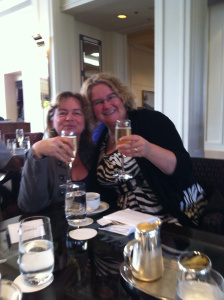
Donna and Nicole
Q: Both of you have work and families, you are part of a writing group (the Canberra SF Guild and part of Fantasy Writers on Retreat), you’re published and you both have books coming out this year (more later), on top of all this, you put your hands up to be co-chairs of Conflux 9. Tell me honestly, when you came home from that meeting and told your significant others that you’d volunteered to run the Nat Con, what did they say? (From the photo it looks like you might have had one glass to many).
Donna
Well that photo on the website was my birthday shot ( a High Tea) so I’m not sure we’d dived into the champers at that time. We think we’re insane and I think our partners know it. Matthew (Farrer) my partner has this wide-eyed stare every time we talk Conflux 9. The worried frown sort of says-‘she’s going to rope me in?’ And just last weekend I did too, do a couple of panels. It’s the power of the inevitable. However, this is definitely my last con.
Nicole
I dreaded telling my husband, Tim, cause he really didn’t like the time it took from me when I chaired Conflux 4. But the fact that a) it was with Donna, so the workload wouldn’t be as bad and b) I love doing this meant he was fine with it. However, we’re both swearing that this will be the last time we organise a con and hoping our partners will keep us to that. Not that that means it’s the last thing we’ll do for the community. We have ideas. One that keeps popping up in particular (you know what I mean, Donna).
Donna
Nicole do not go there. Do not pass go and do not collect $200. Think of the work involved. You’re insane.

Q: Not only are you doing all of the above, but Nicole, you’re teaching Year of the Novel with the QLD Writing Centre and the ACT Writers Centre, and Donna you are doing a Masters in Creative Writing, and a course in Millinery (hat making). Is there a point where you think, I can’t take on one more thing? Or is your philosophy, the more I take on the stimulating life is and it’s just as well I’m really good at juggling?
Donna
I have my limits. Like if I sold a trilogy I’d probably have massive brain melt. But that’s not going to happen in the next 3 months. I’d like it but you know gee a girl can only do so much. Ironically, I do find the more I have on the more productive I get. RSI stymies me a little. I guess it’s a matter of stacking. Conflux is over at the end of April. Things are hotting up now with Conflux so I ease off on the writing. The Masters starts soon, but I’m taking all of April off to get the Conflux thing done and uni if needs me. Millinery if the course goes ahead (they need a minimum number) will be my time out. I have arthritis in the neck and one day I’m not going to be a happy camper so I do have this philosophy of doing as much as I can now rather than waiting until I retire or something. And to ease the pressure in my writing gears and cogs, I wrote two novels in the last half of 2012 and I just have to polish them and send them out this year. The pressure to write has eased a bit.
Nicole
There is no doubt in my mind that I am quite, quite mad. However, there’s nothing that annoys me more than being bored, and this year there’s little chance of that happening! The two Year of the Novel courses were important to me because I love teaching and helping people – I get as much satisfaction from seeing friends and those I’m mentored and taught succeed as I do from my own success. More, even, cause I don’t have to deal with the worry and fretting and constant fear of bad sales figures J And as Donna said Conflux is over is just over three months (eep, eep, eep!) and I’m going easy on myself on the writing front in order to keep things under control. That said – I’ve got two books coming out between now and then, one of which I’m editing and publishing, so… Back to the comment about being mad.
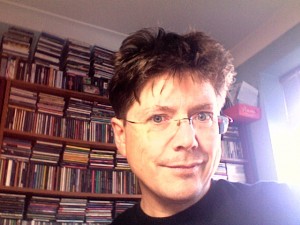
Marc Gascoigne
Q: You’ve been involved in running other Confluxes and other events like the World SF Con 2010. How did you get involved in running events? Was it overwhelming the first time? I know Conflux 9 is running a pitching opportunity with Marc Gascoigne from Angry Robot. Nalo Hopkins is the International writer GOH, Karen Miller is the Australian GOH writer and Kaaron Warren is the Special Guest writer, (see here for details), so you get to meet cool writers and editors. Are there other benefits to running a Con and is it something you’d recommend to people wanting to become writers? (For information on the pitching opportunity see here).
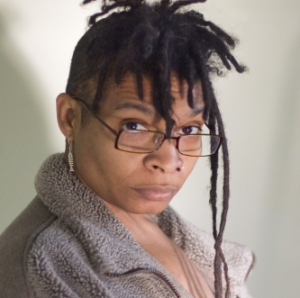
Nalo Hopkins (Photo David Findlay, 2007)
Donna
Nicole will tell you I roped her in. I’ll blame Maxine McArthur because I’d never heard of SF cons (well I had been to a Star Trek convention and knew about those but not fan run lit cons). I ended up being the Chair of Conflux (number 1) but I was just helping out on the committee (cough because Maxine gave me strong hints that I should) and then I ended up being the chair. I did the next one and then scaled down my activities to focus on writing.
I did make a lot of contacts and made many friends as a result. In those early days I was very enthusiastic and networked a lot and I guess brought in other writers to the fan scene. The rest is history. For that first con though I had 10 months off work and I didn’t write much either. I think I did other things like edit anthologies.
I do recommend getting involved with organising these conventions and helping out. It’s a good experience and you make great contacts. However, I do recommend a little balancing between your activities. I got invited to help out with worldcon because I got noticed doing the Conflux convention running. It can be addictive. Worldcons are great fun (going to them and being involved).
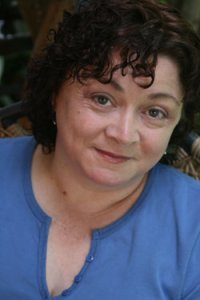
Karen Miller (Photo Mary CT Webber)
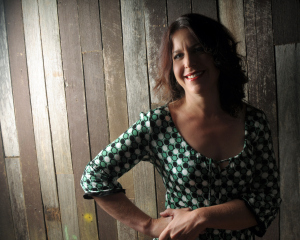
Kaaron Warren
Nicole
Yes, it’s all Donna’s fault. She asked me to run the short story competition at the first Conflux. I wasn’t totally happy with my work on that, so I decided to work on the next convention to prove I could do it. And then the next convention. And then I chaired one. And then. And then…
And now, thanks to Conflux, I work full-time as a professional conference organiser. So yeah, I love them.
I’m not sure I’d recommend it to other writers, because it is very time consuming. That said, if you’re not good at networking (like me, I’m atrocious at it, unlike Donna who is an absolute marvel at it), then getting involved in convention organising is a great idea because you have to meet and interact with these people. I’ve not doubt that my work with Conflux helped me get my foot in the door with Harper Collins. Didn’t get me published – it was the fact the company loved the books that did that, but it helped.
So balance it up – the time it takes versus the fact it can be very beneficial. And fun. And you get to meet the coolest people, and often they’ll stay friends for a long time after.
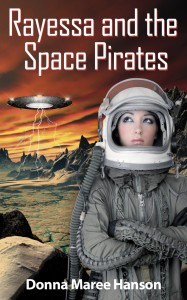
Q: Donna your book Rayessa the Space Pirate is available from Escape Publishing. You edited the Australian Speculative Fiction: Genre Overview, which was published in 2005. You’ve had a lot of short stories published which range from fantasy, through erotic horror, to SF (is this right?), yet Rayessa the Space Pirate is a rollicking Space Opera, which doesn’t take itself too seriously. Was it a relief to let your hair down and write for the fun of it?
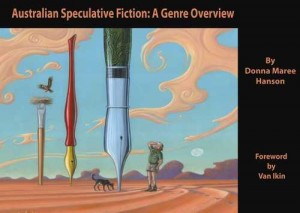
Donna
I had fun writing Rayessa and the Space Pirates. I wrote it a long time ago, when I was a fairly new writer. Even though it’s been revised, I stayed true to the character during those rewrites. She’s fun, the story is fun. But when you take in my other work, it is surely different and not what you’d expect from me. I’m very proud of it because of its lightness, its vibrancy and like you said rollicking space opera.
Many of my short stories are me flexing my writing muscles. I evolved from just writing a story to experimenting with styles and content. I do tend to go a bit dark at times. ‘Heat’ was a bit like that with the split narrative (it’s in my free fiction section on my blog-warning adult content) and in the last couple of years I’d been writing short paranormal too, just to see if I could. I’m a bit astounded that I really like writing happy ever afters just as much as the soul sucking endings. I write what is in my head, pursue ideas and go with it. Who knows what I’m going to do next.
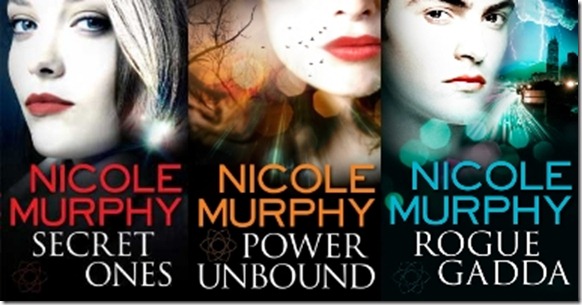
Q: Nicole you’ve had numerous short stories published, and an Urban Fantasy trilogy set in Australia called The Gadda (Harper Collins). The tag-line on your blog is: Where Fantasy and Romance Collide. So your next book’s genre is a step sideway, but not that far. Arranged to Love is written under your pseudonym, Elizabeth Dunk. (For a taste of Elizabeth Dunk’s writing style see here, Claudine’s New Adventure). What was the genesis of Nicole the fantasy writer evolving to include Elizabeth the romance writer?
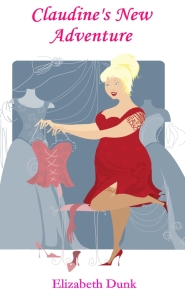
Nicole
It all started way back when I was originally writing the first lot of Gadda books. I’d been thinking I was a straight fantasy/SF writer, but I had one of those blinding moments of inspiration where I realised I kept putting romance in as a sub-plot and I’d probably be better off pulling it to the forefront. That was the genesis of writing the Gadda books and when they were done, I kept having ideas for contemporary romances as well.
In 2011 I was at home, writing full-time, and I needed to do something apart from the Gadda books to challenge myself. So yes, I took a step sideways – a small one, but definitely still a step. My aim was to write a Mills and Boon category style romance. The only way Arranged to Love matches that is in length – otherwise it fails. But it’s a great story and it had a checkered road to publication but I’m so happy it’s there.
I’d always intended to use a pseudonym, but to be open about it because some people read only genre, some people read an author. So there will be people who will read anything I publish and there will be romance readers who won’t touch the Gadda books with a barge pole and vice versa. Here’s hoping it works.
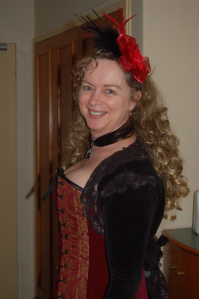
Q: I understand there is a Steampunk High Tea is planned for Conflux 9 on the Thursday afternoon at 3pm. (For the full program, see here). I’m guessing this mean we all get to dress up in really cool steampunk gear, sip tea and nibble cucumber sandwiches. Do you have any fashion advice for the event?
Donna
I think people should go with that they feel comfortable with. I’m dressing up because: hey I made a dress so I must wear it. But people can come with a bow tie, or goggles or a gun or just in day clothes. I bought Matthew a Nerf Gun. I expect him to paint it and make it look all steampunky. My son gave me a steampunk necklace for Christmas. I’m almost kitted up.
It’s a bit of fun. People can do traditional Victorian or make it up with whatever they like. I’ve seen men and women in corsets, kilts, junk, jodhpurs and google, top hats, parasols. Any and all. Just come for the fun and the high tea. I believe we get lovely sparkling wine too. Try googling steampunk clothing and you’ll be amazed at what is out there. Mind bogglingly awesome. There are some very talented and creative people out there. Just remember you have to book and pay for the high tea as it is an extra event.
Nicole
Can I just add – cucumber sandwiches are awesome! Honestly, you read about them and think, how old fashioned, how silly, making sandwiches with cucumber only, what a strange thing to do. But they’re great. I prefer them with a yoghurt dressing, rather than cream cheese. Take note, Rydges!
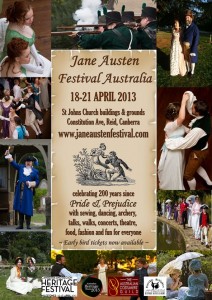
Q: You are also staging a Regency Banquet. Does this involved getting dressed up like Elizabeth and Mr Darcy? What can people expect at a Regency banquet?
Donna
Yes, if you want. We ran a Regency Banquet a few years ago and we had a great turn out. A lot of people love the period and went all out. Some had period costumes, some people adapted modern wear to make it look period, some of those were very effective.
The menu for the banquet is taken from the Conflux cookbook, Five Historical Feasts, by Gillian Polack. We are re-running that. The menu was researched and put together by Gillian, who is our very own historian (she’s a Dr), with the help of a bunch of us who tested and tasted the recipes. The food was really good to eat. Not good for my waistline.
This year to spice things up we have entertainment from Earthly Delights. They are the group that run the Jane Austen Festival in Canberra the week before Conflux. (they always get TV coverage of the event). John Gardiner, his wife Aylwen Gardiner-Garden will be organising the impromptu dancing and also music. John has agreed to do a 3 hour workshop on Regency Dance and Manners on the Friday. I’m so going to that. ($45 for members) and Aylwen is bringing items of costume to do a hands on workshop on costume design ($10 for members), so we are getting into the Regency thing. I hope we get takers because the dance workshop needs 16 people to work.
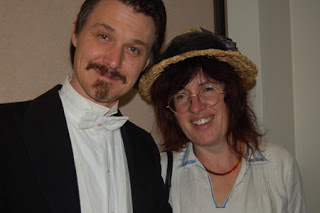
Lewis Morely and Marilyn Pride Conflux 5 (Photo Cat Sparks)
Nicole
The original Regency banquet was run during my conference, Conflux 4 and I may be biased, but I think it was the best of the lot. Everyone really went all out with the costuming and the whole place looked wonderful. The food was overwhelming – there was very little desert eaten because it was so rich we were already full. A fabulous night.
Note that while we’ve cut a lot of allergens out of the menu (eg there’s no fish/shellfish, no nuts), there’s one thing we can’t avoid – dairy. The Regency folks were nuts for it. And butter, so forget your diet! But if you’re lactose intolerant, there’s so little food available for you that you’ve got to seriously consider if it’s worth your while.
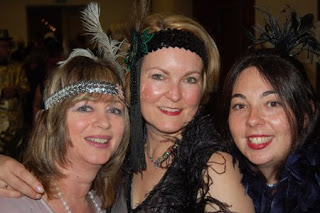
Donna Hanson, Cat Sparks, Alisa Krasnostein, Conflux 5 (Photo by Cat Sparks)
Q: Do you have any tips for first time convention goers who are planning to come to Conflux 9? (For membership information see here)
Donna
Be prepared to meet people, have fun, be entertained, learn things, network (drink). Be prepared to be thoroughly knackered. Come to our Meet the newbie session in the bar after the steampunk high tea. You’ll get to meet seasoned con goers to find out how to make the best of your convention.
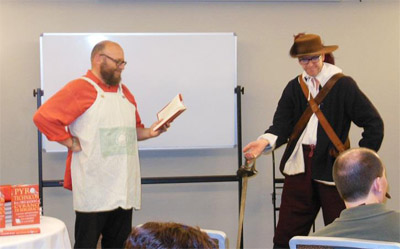
Adam Browne and Keith Stevenson (Photo Claire McKenna)
Nicole
Don’t be afraid to approach your favourite writer. One of the great things about our industry is that we’ve all been in the same boat – having to greet our hero for the first time. A lot of the time, we made complete and utter fools of ourselves but we’ve always survived. Australia’s SF industry is wonderfully supportive, encouraging and fabulous and generally we only bite if asked to.
If you’re coming as a writer, intending to network with editors, agents and publishers – be cool about it. For professionals, conventions are part work, part fun and hanging with friends. So be aware of the circumstances and if you are going to approach them for a chat about your work, be polite and understand if they ask you to come back another time.
And whatever you do – don’t do what some shmuck did to poor Stephen King at a convention and chase a writer/editor/agent/publisher into the toilet with your manuscript and fling it under the door to them!
That said, a lot of us are very bribable. I drink red wine 🙂
Rowena thanks for the interview. You’ve done heaps of research. It is much appreciated.
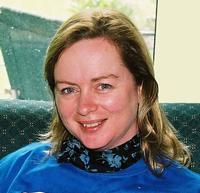
Donna Hanson
Catch up with Donna on GoodReads
Donna’s blog
Follow Donna on Twitter @DonnaMHanson
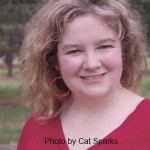
Nicole Murphy
Catch up with Nicole on GoodReads
Nicole’s Blog
Catch up with Nicole on Facebook
Follow Nicole on Twitter @nicole_r_murphy
Filed under Australian Artists, Australian Writers, Conferences and Conventions, Conventions, creativity, Dark Urban Fantasy, Fandom, Fantasy books, Fun Stuff, Indy Press, Pitching your book, Promoting your Book, Publishing Industry, SF Books, Specialist Bookshops, Steampunk, The Writing Fraternity, Tips for Developing Artists, Tips for Developing Writers, Workshop/s, Writing craft, Writing Groups
Tagged as Arranged to Love, Claudine's New Adventure, Conflux 9, Donna Hanson, Elizabeth Dunk, Gadda trilogy, Jane Austen, Kaaron Warron, Karen Miller, Marac Gascoigne, Nalo Hopkins, National SF Convention, Nicole Murphy, Pitching Opportunity, Rayessa and the Space Pirates, Steam Punk
September 9, 2012 · 8:33 pm
I’m expanding my series featuring fantastic authors to include fantastically creative people across the different mediums, which is why I’ve invited the World Fantasy nominee Kathleen Jennings who is both a writer and an artist to drop by.
Watch out for the give-away question at the end of the interview.
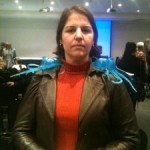 Q: In 2009 you won the Inaugural Kris Hembury Encouragement Emerging Writers and Artists Award. Kris attended one of the EnVisions (a mentoring workshop for writers) and worked on the Fantastic Qld committee as well as serving as president for the Vision Writers group. He had such a dry sense of humour. As an emerging writer and artist how did winning this award impact on you?
Q: In 2009 you won the Inaugural Kris Hembury Encouragement Emerging Writers and Artists Award. Kris attended one of the EnVisions (a mentoring workshop for writers) and worked on the Fantastic Qld committee as well as serving as president for the Vision Writers group. He had such a dry sense of humour. As an emerging writer and artist how did winning this award impact on you?
Kris was a friend, and so it was quite emotional and a huge honour – that’s the personal impact. As a writer and artist, the impact was in realising that what I did was in some way seen by other people. Both writing and art can be (to varying extents) highly subjective pursuits, and realising that it isn’t all happening only in my own head is like opening a window and getting fresh air. I think that sort of combined shout of “we see you!” and “come on in, the water’s fine!” from people further out is a big gift more experienced people can give to those just starting. And one of the best compliments I can give the SF writing scene in Australia is that I have always found them very warm, tolerant and encouraging to awkward and easily startled beginners.
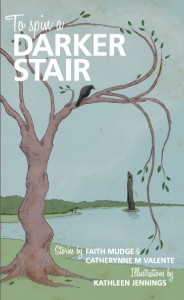 Q: Kathleen has been nominated for the World Fantasy Award in the Art section. When you were a child did you ever think you’d be nominated for the World fantasy Art Award and do your parents finally believe you’re a ‘real’ artist now?
Q: Kathleen has been nominated for the World Fantasy Award in the Art section. When you were a child did you ever think you’d be nominated for the World fantasy Art Award and do your parents finally believe you’re a ‘real’ artist now?
I never even dreamed about it! I recall planning to be an author, or a champion poultry-breeder, or something like that.
As for my parents, they always thought of me as a real writer, so I think the art just required a slight readjustment. I suspect they are slightly disappointed that now they just get to show their friends copies of my pictures, instead of holding them down and reading high-school essays to them. They are recovering gracefully, and fantasy art is sometimes more generally socially acceptable than fantasy writing, but I suspect they’d really like to see my art on a book with my name on it.
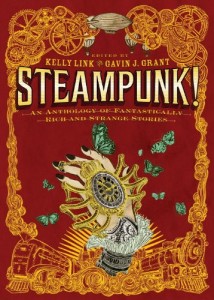 Q: Your short stories have appeared in ‘Antipodean SF, the Shadow Box anthology, Andromeda Spaceways Inflight Magazine #41 and #52, After the Rain, Light Touch Paper Stand Clear and a comic in Candlewick Press’ Steampunk!.’ You were the president of the Vision writers group in 2009, 2010 and 2011. How useful is belonging to a group for the development of a writer?
Q: Your short stories have appeared in ‘Antipodean SF, the Shadow Box anthology, Andromeda Spaceways Inflight Magazine #41 and #52, After the Rain, Light Touch Paper Stand Clear and a comic in Candlewick Press’ Steampunk!.’ You were the president of the Vision writers group in 2009, 2010 and 2011. How useful is belonging to a group for the development of a writer?
I found it very useful – it’s another of those things which teaches a distinction between subjective and objective assessment of my work. It took me out of my own head (and writhing self-referential angst) and taught me how to write better, how to be dispassionate about editing (this lesson hasn’t entirely taken yet), how to put my work out there and receive comment on it, and also how to tell the difference between genuine constructive criticism and the personal taste of the reader. But more importantly, it was the beginning of a great many friendships and personal and professional connections, as all the people grew up and out and graduated into new stages of their careers, new pursuits and interests, sharing dreams and ideas and projects. I remember Catherynne Valente wrote a beautiful review of Midnight in Paris, and said of the dream it shows of the literary/artistic scene in 1920s Paris, that as writers “this is what we are meant to get instead of health insurance!”. And it is, but we also get to build it fresh each time for ourselves.
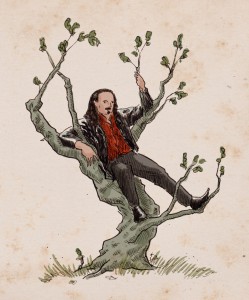
Jason Nahrung
Q: You have done covers and illustrations for Small Beer Press, Subterranean Press, Fablecroft Press, Andromeda Spaceways Inflight Magazine, Ticonderoga Publications, Odyssey Press and the Canberra Speculative Fiction Guild as well as individual commissions. Can you walk us through how someone would approach you to commission work?
It starts with an email or a twitter message, although sometimes there have been oblique advance hints given at a convention or over coffee. I panic (either from surprise or scheduling) then say yes, give a quote (once there’s enough information) and get the brief. This includes dimensions, details of style, particular limitations, directions the publisher/client would like to go in and the date. The date is very important! “As soon as possible” is not a date, it is a shifting target on the far side of other dates (this is a public service announcement, in case I forget to ask for one: everyone is happier with dates!). There is a varying degree of freedom – anything from “whatever you want” to “precisely these scenes”. For covers, I do like some idea of preference or at least direction. It helps to narrow my focus and the restrictions give more scope for creativity. Also, the cover is for marketing as well as decoration, and it’s good to know what the publisher’s thoughts are in that direction. Good art direction is invaluable. Then I read the manuscript (although once or twice this hasn’t been an option), weep, angst, do several thumbnail sketches, send them for approval and – sometimes after some back-and-forth (usually by email, rarely and delightfully over coffee) – get started on the final sketch which will develop into the final artwork.
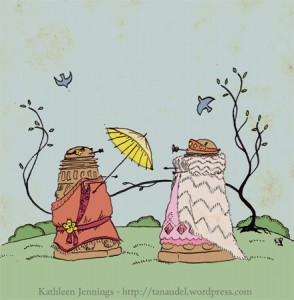 Q: I used to work as a graphic artist illustrating children’s books and write. I eventually found the answer to the question: Was I an artist who wrote, or a writer who drew? (See Kathleen’s sketch books). Which do you see yourself as? And do you think it matters?
Q: I used to work as a graphic artist illustrating children’s books and write. I eventually found the answer to the question: Was I an artist who wrote, or a writer who drew? (See Kathleen’s sketch books). Which do you see yourself as? And do you think it matters?
I see myself as a storyteller (or at least, a lover of stories) who works in words and pictures. My favourite works in all media (art, writing, music, architecture, landscape gardening…) either tell, suggest or provide scope for a story. When I write, I sometimes plot in pictures. When I draw, I try to get a story in there (at least in my mind) – something beyond the purely ornamental. Oddly, although I enjoy comics, I prefer heavily illustrated prose at present – possibly due to circumstances surrounding the last comic work I did (mild heat stroke at one end and floods at the other)! Perhaps the illustrated novel gives more scope for imagination in the space between words and text? I have not analysed this yet.
I do find it difficult to do both, but this is purely because of time constraints (I have a day job, and there are more art deadlines). The writing gets done but I am learning that I have to be much more structured to make the editing happen. But it is happening!
Art and writing complement each other well. It’s nice to be able to switch when I get plunged into creative despair in one area. But I also harbour the hope that the rise of ebooks will somehow elevate the importance of beautifully produced hard-copy books, with elegant design, typography, illustrations, initial capitals and endpapers.
Also, it’s beautiful to be able to interact with my favourite writers as an artist, and my favourite artists as a writer, because that’s pretty much the only way I’m able to string two words together in their presence.
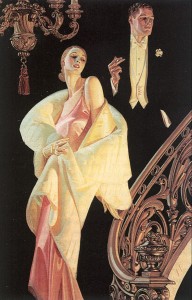
Q: You have said your influences are Brett, Leyendecker and Sender. I love Leyendecker’s work. (He did the Arrow Shirt adverts and many covers for American Weekly). Eg. Having struggled to make ends meet as an illustrator, this picture is one of my Leyendecker favourites:
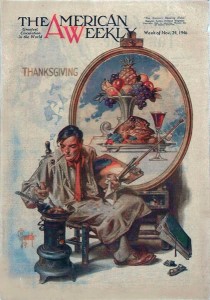 Of course, Leyendecker was highly successful and made a good living from his art. But that was back in the day when the American Weekly needed painted covers. (It was also back in the day when a short story writer could make a living as a writer). What is it about Leyendecker’s art that appeals to you?
Of course, Leyendecker was highly successful and made a good living from his art. But that was back in the day when the American Weekly needed painted covers. (It was also back in the day when a short story writer could make a living as a writer). What is it about Leyendecker’s art that appeals to you?
Truthfully, it’s the hard edge he gives to paintings of soft curls. I had a book of fairytales when I was little, and the illustrations had a similar amazing richness – the “Cinderella” was the three-ball version, each dress was more beautiful and gold-embroidered than the last, but mostly I remember the angular painting of the hair, and the square toes of the stepsisters’ satin shoes. When I discovered Leyendecker, I fell in love with him for that. I also love the visible brush-strokes in sleek pictures, the combination of intense drama with dignity, and the sense that if he took himself seriously it wasn’t in a dull way – there’s this edge either of humour or superciliousness in the most elegant pictures which (for all the formal poses and decorative arrangements) adds tension and therefore an element of story to his pictures.
![midnight-and-moonshine-web[2]](http://www.rowena-cory-daniells.com/wp-content/uploads/2012/09/midnight-and-moonshine-web2.jpg)
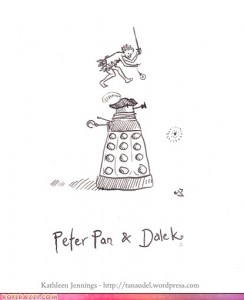 Q: You have done a series of cartoons with Daleks as the central theme (these were shortlisted for a Ditmar). Why Daleks?
Q: You have done a series of cartoons with Daleks as the central theme (these were shortlisted for a Ditmar). Why Daleks?
They are simple and implacable, which makes them wonderful recurring villains: predictable, consistent, unstoppable. But – well, I never thought I’d draw a connection between Leyendecker and the Daleks! – there is a note in their voices that isn’t robotic. It isn’t “you will be assimilated”, it isn’t unvarying. There’s a rising note of anxiety to it, panic, real hatred. Inside those shells are these neurotic balls of intense, obsessive emotion. It creates that same Leyendecker tension between the presentation and underlying feeling. So – I’m a fan of Daleks.
As for the use of Daleks in the game (it was nearly, and may one day be, ducks) – I like parlour games, word games, lying-around-and-being-silly games, so tossing the Daleks (who didn’t do anything to deserve it) into a series of unlikely scenarios amused me vastly.
The rest of the game is an excuse to muse about books I love, or tropes in genre, or memories of reading around the table when I was growing up.
 Q: Your art has been shortlisted for a Ditmar and won the Ditmar Award for: ‘Finishing School” in Steampunk!: An Anthology of Fantastically Rich and Strange Stories’. Do you have a favourite amongst your covers or illustrations and if so, why?
Q: Your art has been shortlisted for a Ditmar and won the Ditmar Award for: ‘Finishing School” in Steampunk!: An Anthology of Fantastically Rich and Strange Stories’. Do you have a favourite amongst your covers or illustrations and if so, why?
Generally, the second-last one. The last one is a victim of temporary trauma-induced amnesia, the current one is just traumatic and I’ve learned so much in doing each cover that I get a little eye-twitch looking at some of the earlier ones! My favourite parts of covers are usually anything new I was allowed to get away with, and the back.
Among the covers, my current favourite is probably the cover for Subterranean Press’ 10th anniversary edition of Kelly Link’s Stranger Things Happen. I was very excited to be asked to draw it because I’m a big fan of Kelly’s writing (although I tend to write very fragmented stories after I’ve been reading hers – the structure of “Kindling” in Light Touch Paper Stand Clearwas a victim of speed-reading Stranger Things Happen for this cover), and then to be allowed to get away with a two-tone, wallpaper/toile effect that I’d been wanting to try! Also, there’s a lightness to the linework which I’m always working to achieve in finished work instead of just in sketches, and I’m still fond of the peacocks on the back cover. And I love the typography (which isn’t my doing!). It’s very gratifying to have good typography put with your art – I have a theory that good typography can save bad art, but good art can’t necessarily lift bad typography.
I’m still recovering from the trauma of Midnight and Moonshine, but I am very happy with how (under duress!) it developed the style which Small Beer Press and Sofia Samatar made me discover for A Stranger in Olondria. I learned a lot doing the cover for Olondria, and still view it through a filter of “if I were to do it again I’d…”, but there are parts of it of which I am excessively fond – certain squiggles of colour, the light through a window, the subject matter.
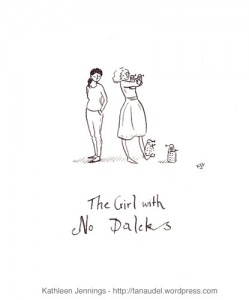 Q: I was prompted to start this series of interviews because there seems to be a perception in the US and the UK that fantasy (in books) is a bit of a boy’s club. I’ve come across quite a bit of talk on the blogs recently about female comic artists and writers, and their lack of representation in large companies like DC (where the money is). Have you come across this in your professional life?
Q: I was prompted to start this series of interviews because there seems to be a perception in the US and the UK that fantasy (in books) is a bit of a boy’s club. I’ve come across quite a bit of talk on the blogs recently about female comic artists and writers, and their lack of representation in large companies like DC (where the money is). Have you come across this in your professional life?
I haven’t directly. However, professionally I’ve been raised by writers, which in terms of my illustrations is basically like being raised by wolves. Also, although I’m very aware of the tensions in the comics worlds, I came into comics through short story anthologies so haven’t strayed into that scene. A lot of the women whose work I like are in the illustrative/graphic scene and there appears to be a lot of support and collaboration without regard to gender, so perhaps it is less gendered there? Also, with the fantasy side of illustration the delicate, elegant, beautiful and decorative is highly prized. You’d think something described with those words could easily be segregated into “women’s work” but isn’t at all (think Charles Vess!) and that’s wonderful. And even the sentimental end of that spectrum has a lot of men working in it so there doesn’t seem to be that danger of being “women’s art”. But again, I’m working mostly from printed evidence. I’ll be able to report further once I know more about that community.
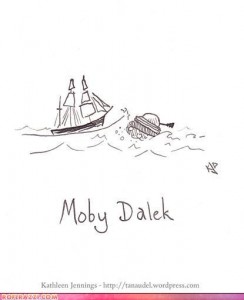 Q: Following on from that, does the gender of the writer/artist change your expectations when you approach their work?
Q: Following on from that, does the gender of the writer/artist change your expectations when you approach their work?
I’m aware that I have held some of the prejudices I referred to in the answer above! I suspect these are hold-overs from some experiences in the writing scene. So I’m usually trying to hold these at bay, not get exasperated by sentimentality or chain mail bikinis as a knee-jerk reaction, or be thrilled at discovering a harder edge in a picture drawn by a woman, or sensible clothing in pictures drawn by a man. I draw sentimental pictures! I have drawn chain mail bikinis! And my favourite things – beauty anchored by fleshy reality or a low rumble of tension, ugliness liberated by common sense or incredible observation – appear in my favourite pictures by my favourite artists, and are usually fairly evenly gender-distributed.
Q: And here’s the fun question. If you could book a trip on a time machine, where and when would you go, and why?
I don’t think about this much! My father discouraged my sister and I from saying “I wish”, because it meant we weren’t happy with the way things were. And if we said we weren’t happy, well then obviously something should be done about that. Which led to some interesting home alterations. However! although I’m fascinated by much of the past, it’s usually the inconvenient parts, and I’m a big fan of modern medicine, amenities and so forth (I get this from my mother, who refused to go camping as it was primitive enough at the house).
So where would I go? I think I already mentioned Midnight in Paris? But oh! I don’t know. Probably not the future (which is odd, because I always like to be very well prepared for upcoming adventures). So – yes – probably that threshold age of the 1920s, when the world was just becoming recognisably ours, and was damaged and new and leggy, hopeless, hopeful, decadent, rebuilding, pragmatic but still with an eye for beauty, taking to the skies. As for where – England for Sayers, or Melbourne for Lindsays, or anywhere with an active literary/artistic community.
Or else just an evening (last weekend, or the last convention, or home, or some recent café) full of conversation and pen-and-paper games, songs, plotting, coffee, cupcakes, genre snark, story-telling, cider, word origins and drawing on serviettes.
Give-away Question: How should words and pictures work together?
Give-away: A little ink drawing of a famous quote with a word replaced by “duck” (artist retains right of veto/negotiation on quote, because I don’t have time to draw 14 ducks again – you don’t realise how many ducks that is until you have to draw them, but it is a lot of ducks).
a Rafflecopter giveaway
Follow Kathleen on Twitter: @tanaudel
July 11, 2012 · 9:07 am

Bruce with Apple Blossom (1977)
I have been featuring fantastic female fantasy authors (see disclaimer) but this has morphed into interesting people in the speculative fiction world. Today I’ve invited the hardworking and insightful Bruce Gillespie to drop by.
I first met Bruce in 1976, when I went to Melbourne with Paul Collins to start an Indie Press publishing house. Bruce was living in Carlton with his cat Flodnap (and his cat’s cat, Julius) and had been editing fanzines for 8 years. By 1976, Bruce had been nominated for a Hugo three times, so despite being only 29, he was already one of the Grand Old Men of Australian SF Fandom.
Q: Your work had received three Hugo Nominations before you were 30. You have received total of 45 Ditmar Nominations and 19 wins, and The A Bertram Chandler Award in 2007, plus you were fan guest of honour at AussieCon 3, the World SF Convention in 1999, is there anything left that you would like to achieve?
 A: Like any other fanzine editor or writer, I would actually like to win the Hugo Award for either Best Fanzine or Best Fan Writer! But that seems impossible these days, since even in 1999 and 2010, when the world convention was held in Australia, I could not gain enough votes to reach the nominations list.
A: Like any other fanzine editor or writer, I would actually like to win the Hugo Award for either Best Fanzine or Best Fan Writer! But that seems impossible these days, since even in 1999 and 2010, when the world convention was held in Australia, I could not gain enough votes to reach the nominations list.
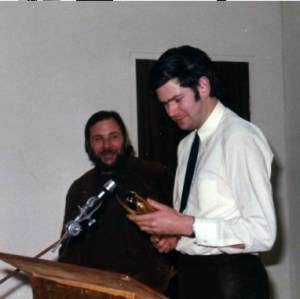
Bruce receives his first Ditmar from John Bangsund (1972)
However, in 2009 I was awarded the Best Fan Writer in the annual FAAN Awards, given by my peers, the fanzine writers and editors who attend the Corflu convention in America. I count that as a great honour, along with having received Australia’s two awards for lifetime achievement, the A. Bertram Chandler Award (as you mention) and the Peter MacNamara Award. In practical
terms, the greatest honour I’ve received was the Bring Bruce Bayside fan fund, which enabled me to return to America (for the Corflu and Potlatch conventions) for a month in 2005.

- The Gang (1967)
John Bangsund, Leigh Edmonds, Lee Harding, John Foyster, Tony Thomas, Merv Binns and Paul J Stevens
- The Gang (1967)
Q: In your 2012 snapshot interview you say: A fanzine is a minor artform, based on putting together a wide range of material from my favourite writers, plus response from letter writers from all over the world. The use of a computer limits the artform in some ways, but also offers design, editing and font possibilities that were impossible to access in the Good Old Days (pre 1990s) of using stencils and duplicators.’ You have been producing zines now since 1968, that’s 44 years. In that time you must have worked out what makes a good fanzine. If you could go back now to Bruce circa 1968, what advice would you give him?
 A: I could have warned him not to use the typewriter with which I produced the first SF Commentary in 1969. It was a little Olivetti with a beautiful typewriter face — but unfortunately it would not cut a stencil properly. For a fanzine that was almost illegible, SF Commentary No 1 gained an enormous response from people around the world, including a letter from Philip K. Dick, my favourite SF writer.
A: I could have warned him not to use the typewriter with which I produced the first SF Commentary in 1969. It was a little Olivetti with a beautiful typewriter face — but unfortunately it would not cut a stencil properly. For a fanzine that was almost illegible, SF Commentary No 1 gained an enormous response from people around the world, including a letter from Philip K. Dick, my favourite SF writer.
But apart from that, how can you give advice to a 22-year-old, especially someone with far more energy than I have now? ‘Follow your nose?’ ‘Never give up?’ I knew then that no matter how people responded to my fanzines, that was what I should be doing. Nothing’s changed.

Bruce with Brian Aldiss at Stone henge (1974)
Q: In the same interview you said: ‘Of course, I can publish electronically, using PDF files, on Bill Burns’ wonderful efanzines.com, but I know that many people download such magazines and don’t read them with the attention they would devote to a magazine they received through the mail.’ I do most of my reading on-line, following science blogs, political activists and researching. Personally, I don’t feel that I give less attention to my on-line reading. What leads you to believe that an on-line magazine is valued less than a print magazine?
A: For someone of my generation, a paper document has real existence, and online documents don’t. I don’t really believe that the current electronic publications will be available or readable in twenty years, let alone forty, but I still own almost all the paper fanzines I’ve received since 1969. If I value anything I find Out There, I copy it into a Word file and print it. More to the point, many of my correspondents say that they reply to paper fanzines, and don’t respond to fanzines posted on efanzines.com. That’s if they even take the trouble to download.
The current situation is that I can no longer afford to print and post my fanzines, so I will be asking almost all my readers to download them. This will sharply reduce the number of letters of comment I receive, but it gives me much more freedom to publish much more often.
Q: You once said about Fandom: ‘Before I joined fandom I had almost no friends or anybody with whom I could share my interests. In fandom I found people who were not just another part of the mundane world, which I find stifling. During a weekend I spent at Lee Harding’s place in late 1967, I met for the first time many of the people who have had the most influence on my life, such as John Bangsund, Lee Harding, George Turner, John Foyster and Rob Gerrand.’ (See Bruce’s post about science fiction and fandom here). I must admit that it wasn’t until I came to Melbourne with Paul in 1976 that I met people I could talk to. I’d come from Brisbane where all people talked about was football and getting drunk (obviously I was moving in the wrong circles). In Melbourne fandom I met fascinating people who could hold stimulating conversations on all manner of topics. I felt like I’d come ‘home’. Nowadays with the WWW people can make contact with other like-minded people, but forty years ago it was much harder. SF fans were considered extremely odd. Can you give readers a glimpse of what it was like to be a fan in those days?

Melbourne Fandom in 1954
Back row: Merv Binns, and Dick Jenssen
Front row: Bob McCubbin, Bert Chandler and Race Mathews
A: At school, I had only two friends who read science fiction at all. Nobody else I knew read SF, although the SF magazines were much more widely available (in newsagents) than now. At university, no other students seemed interested. However, I did read in the Bulletin in 1966 that Melbourne had just held an SF convention. Charles Higham wrote what remains the fairest report any Australian journalist has ever offered of an SF convention. He made it sound very exciting. I also knew that the Melbourne SF Club held its meetings every Wednesday night in Somerset Place, which was behind McGill’s Newsagency in Elizabeth Street. McGill’s had the only good stock of science fiction in Melbourne, and I realised that this had something to do with the tall thin man who loomed behind the counter (who was, of course, Mervyn Binns, who has just been given the Infinity Award for his services to fandom). Every science fiction book sold in McGill’s included a little leaflet advertising the club. Also, McGill’s sold a magazine called Australian Science Fiction Review (ASFR). The quality of the reviews and articles in this magazine were staggeringly far ahead of those in the pro SF magazines, for both intellectual content and sparkling style. However, I knew I would never finish my degree if I became involved in fandom from 1965 to 1967. At the end of 1967 I wrote several articles on the works of Philip K. Dick and sent them to John Bangsund, the editor of ASFR. He rang me in December 1967 and suggested I visit his home in Ferntree Gully to meet the people who produced the magazine. This was the beginning of my career in fandom, for I met people who read what I read, talked about what interested me, and who were interested in what I had already written.

Bruce with Allan Sandercock (1971)
Q: You are a qualified school teacher and did teach for two years, but gave it up to produce fanzines and write about speculative fiction. You said: ‘My mundane career has never gone anywhere much, and I’ve often been nearly broke. But my career in fandom (as an editor), which has never made me any money, has led to most of the good things in my life.’ What do you think are essential traits an editor needs?
A: That’s not quite right. I gave up teaching because I was hopeless at it. I was very close to suicide at the end of 1970, but a friend prompted me to do what I would have thought unthinkable — resign. When I did this, the Department wanted to keep teachers, so I was offered a series of bribes to stay officially a teacher. The last of these was a position in the Publications Branch of the Department. In 1971 and 1972 I received a full on-the-job training in professional editing and journalism. I left in mid 1973 to go overseas, visiting fans all over America for four months and a month in Britain. When I returned I decided to try freelance book editing. I knew there was no editing work in SF in Australia, but my friend John Bangsund was making an intermittent living from freelancing, and there was plenty of work, especially in textbooks, in 1974.
The essential quality of an editor is to love correcting other people’s writing. You trawl through a book and can see how you can improve it. Many editors (especially my wife Elaine) are much better at it (are much more meticulous) than I am, but I’ve kept on working over the years, sometimes successfully (as during the twelve years I received guaranteed freelance work from Macmillan in Melbourne) and sometimes disastrously (such as at the end of 1976, when I was actually forced to take a part-time office job for a year or so). Elaine and I have learned to skate along from cheque to cheque, and sometimes those cheques are very thin on the ground.

Bruce Gillespie and Elaine Cochrane on their Wedding Day (1979)
Q: In 1979 along with Carey Handfield and Rob Gerrand, you were one of the founding editors of Norstrilia Press, which published Greg Egan’s first novel, among others. Was there are particular philosophy that the three of you developed when you started Nostrilia Press?

Dick Jenssen and Rob Gerrand (2005)

Bruce Gillespie and Carey Handfield (1975)
A: Like the other small presses of the time, including Cory & Collins and Hyland House, our aim was to publish material that no major publisher would touch. You might remember that during 1973, for instance, there were 17 novels of any genre published by all Australian publishers. Even after the Australia Council began its publishing program under the Whitlam Labor Government, most of the spate of new titles sprang from the small press enterprises, such as Outback Press.
Carey said that the aim of Norstrilia Press (named in honour of American writer Cordwainer Smith, who had a great love of Australia, and whose only novel was Norstrilia) was to return enough money to SF Commentary, my magazine, to keep it going. This never happened, of course, but our first book (1975) was a set of essays called Philip K. Dick: Electric Shepherd. All the material, which included essays by Stanislaw Lem and George Turner, came from SF Commentary.

Carey devised a complicated system by which individual fans invested in particular books that we published. Since eventually we had to provide a return on investment, we diversified quickly. (Our only other critical book was The Stellar Gauge, essays by the finest critics in the field, edited by Michael Tolley and Kirpal Singh in 1981).
 Our second book was The Altered I, with stories and essays based on the Ursula Le Guin Writers Workshop of 1975 (held in association with Australia’s first world convention, Aussiecon 1).
Our second book was The Altered I, with stories and essays based on the Ursula Le Guin Writers Workshop of 1975 (held in association with Australia’s first world convention, Aussiecon 1).
We tracked down a novel by Keith Antill called Moon in the Ground. It had won a prize several years before, but had never found a publisher.
Greg Egan sent us his An Unusual Angle, a brilliant novel he had written when he was seventeen.
I had met Gerald Murnane at Publications Branch, and had typed several of his novels before he learned to type. In 1977 I suggested that one section of a giant novel would make a great book on its own. That became The Plains in 1982, which was our greatest success (gaining a nomination for The Age Book of the Year Award), and still Gerald’s best regarded book. Text Publishing has just produced yet another edition, and it has had several overseas editions.
We were also very pleased to publish George Turner’s literary memoir In the Heart or in the Head, as well as The View from the Edge, his book about the 1977 Writers Workshop held at Monash University.
However, all of Carey’s and Rob’s labours were unpaid, and I was paid only for the typesetting work that I did for Norstrilia Press, Cory & Collins and Hyland House. At the end of ten years, we had made very little money, and Carey wanted to get married and establish his own career. So Norstrilia Press finished in 1985.

John Foyster, Carey Handfield, Damien Broderick and John Bangsund (1982)
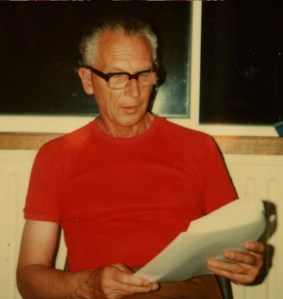
George Turner (1979)
Q: You are the executor for George Turner’s literary estate. What exactly does being a Literary Executor entail?
A: Not a lot, because George has not exactly been popular since his death in 1997. His main audience was overseas, and all those editions have gone out of print. Most of the work in keeping his name alive has been done by his agent, now my agent, Cherry Weiner, an Australian who has lived near New York for many years. At various times she has had great success with various Australian authors, such as Keith Taylor, Wynne Whiteford, David Lake, and now Paul Collins. She sold George’s posthumous novel Down There in Darkness, in 1998, but little since. I’ve signed contracts for Gollancz in Britain to republish The Sea and Summer (Drowning Towers in USA) as an SF Masterwork. I’m hoping that when it appears, it will re-establish George Turner as one of the major SF talents of the last fifty years.
I did publish 100,000 words of George Turner’s non-fiction as SF Commentary 76. Copies are still available, both as download and as a paper magazine.

Aussice Con 3 Timebinders Panel (1999)
Q: I was prompted to start this series of interviews because there seems to be a perception in the US and the UK that fantasy and particularly SF is a bit of a boy’s club. Do you think there’s a difference in the way males and females write?
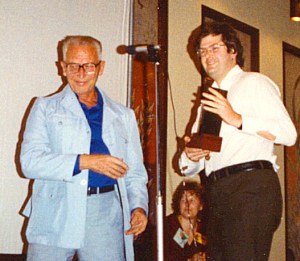
Bruce receives a Ditmar from George Turner (1980s)
A: Are we talking about science fiction or fantasy? To me they are quite different fields, with fantasy dealing with impossible events; and SF, at its best, being realistic novels that happen to be set in the future, rather than in the present or the past.
And are we talking about the writers or the readers? The balance in the composition of the readership changed very rapidly. When I became involved in SF fandom, the only women who turned up at conventions and club meetings were girlfriends or wives or members. That’s in 1968 and 1969. This began to change rapidly after 1971, mainly because of the influx of younger female media fans, but also a lot of women who were just beginning their careers as academics, teachers and librarians. By the 1973 Easter convention held in Melbourne, nearly half of the attendees were women, and that balance has remained even ever since.
But Australian writers, who were mainly male (Damien Broderick, Lee Harding, David Boutland, Jack Wodhams and Wynne Whiteford) tended to huddle in corners in the early 1970s because there were very few of them. There had been a very famous Australian female writer, Norma Hemming, but she had died in 1960 when she was very young. Cherry Wilder lived in Sydney for awhile, but she was a New Zealander with a German husband, so she went to live in Germany in the late 1970s.
The balance changed after fantasy became the dominant publishing genre in Australia in the 1990s. When HarperVoyager began consciously to recruit Australian writers, they found a treasure trove of young, enthusiastic women writers who have become very popular. Science fiction almost disappeared here, except from a few (male) writers such as Sean William, Sean McMullen and Terry Dowling. Marianne de Pierres and Lucy Sussex seem to be our only female writers who publish mainly science fiction.
All you have to do is look around at any fannish or professional gathering in Australia to see that 80 per cent or more of our writers are now female. They include many of my own favourite dark fantasy writers, such as Kaaron Warren, Cat Sparks and Deb Biancotti. I don’t read three-parter blockbuster medieval fantasy novels myself, but I acknowledge that Australia’s female writers (as well as a few males, such as Garth Nix) have conquered the field.
Q: Following on from that, does the gender of the writer change your expectations when you pick up their book?

Bruce receives the Chandler award from Paul Collins and Kirstyn McDermott (2011)
A: I’m only interested in finding good writing. I can’t help sympathising with Gerald Murnane’s rather provocative statement that no book should be published with the name of the author visible. In other words, the prose should speak for itself. Aesthetics über alles. However, like most readers I’m curious the find out about the authors whose works I enjoyed most, and I can’t help being flattered if my favourite writers remember something I might have written about their work. But I admit that most of my favourite SF writers have been male, for example, Philip Dick, Brian Aldiss, Thomas M. Disch, Cordwainer Smith, George Turner, Wilson Tucker, Stanislaw Lem and Christopher Priest. I always buy every new book by Ursula Le Guin. I love Joanna Russ’s work, but her novels were not as interesting as her short stories. I’ve enjoyed some of Gwyneth Jones’ books, but not all. In literary fantasy, nothing beats Le Guin’s Earthsea series and Diana Wynne Jones’s novels, but I also love fantasy by Peter Beagle, Italo Calvino, Steven Millhauser and a whole lot of others.
Q: And here’s the fun question. If you could book a trip on a time machine, where and when would you go, and why?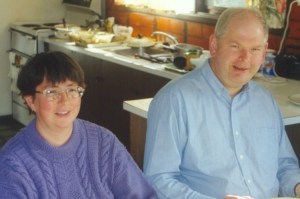
A: As the Strugatsky Brothers reminded us in their fun novel, Hard to Be a God, any of us would find any past era very smelly and very dangerous. Given the right inoculations (and nose filters), I would like to investigate the period that the Steampunkers have adopted as theirs, that very exciting era of huge change from 1880 to 1914. You would have to think that the First World War was staged to destroy that tremendous fizz of progressive thinking and scientific and artistic change that seemed likely to lead to a brave new world. How were they were to know in 1914 that millions would be killed, and that Stalin and Hitler would divide the world’s attention for the next thirty years?
For a list of Bruce’s publications and essays see here.
For Bruce’s listing on the e-fanzine site, with links to all his fanzines, see here.

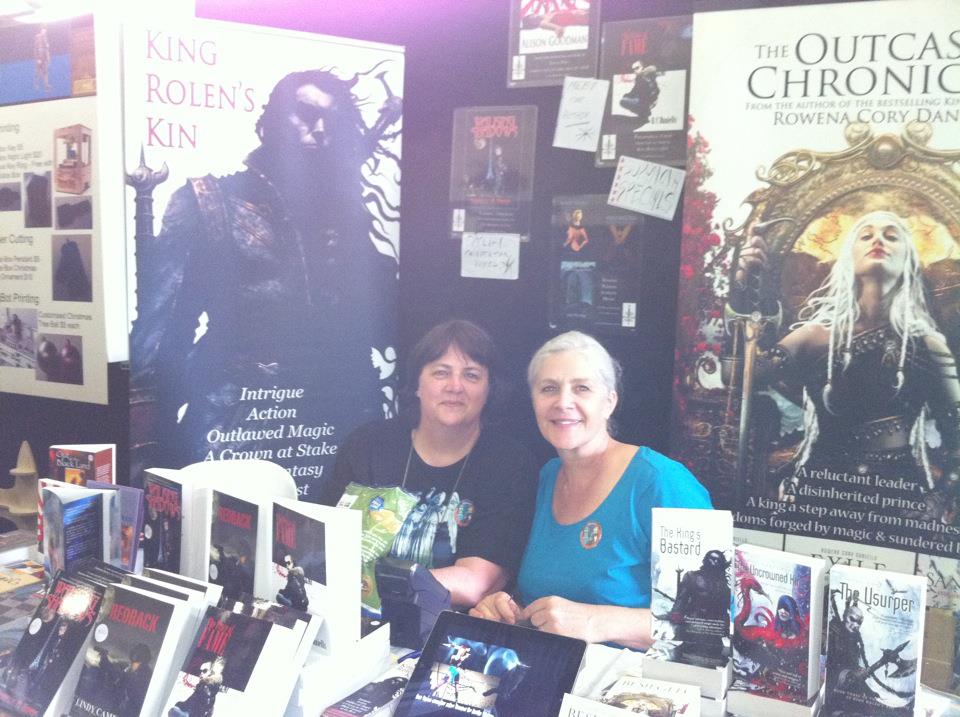
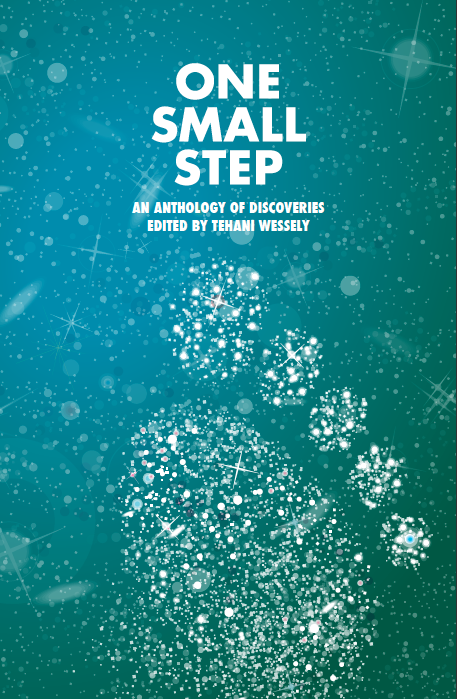










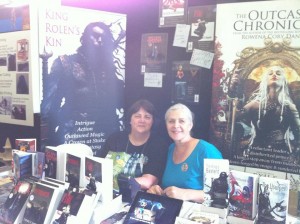
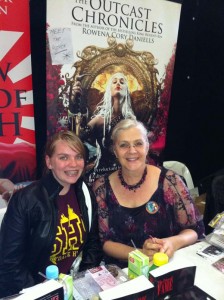
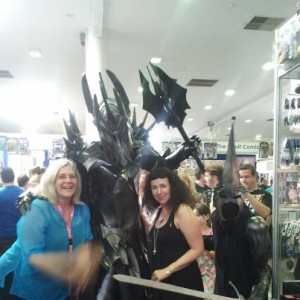

















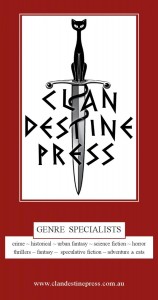
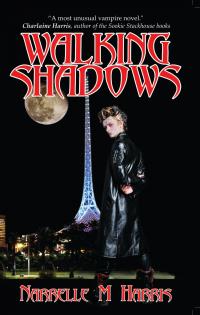
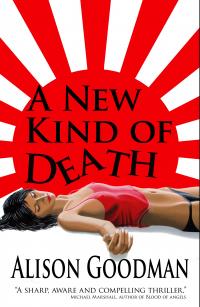
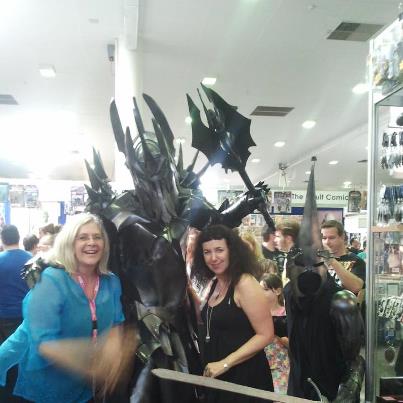







![midnight-and-moonshine-web[2]](http://www.rowena-cory-daniells.com/wp-content/uploads/2012/09/midnight-and-moonshine-web2.jpg)























